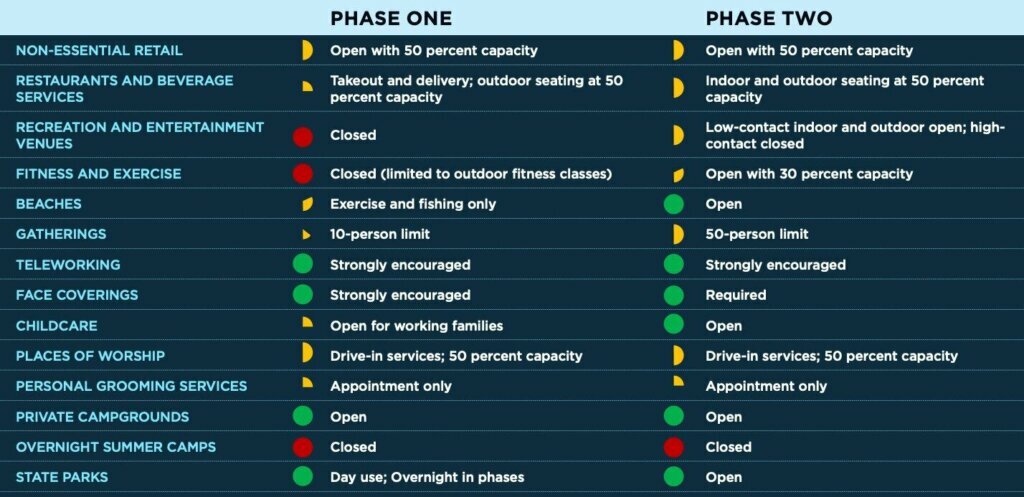Northern Virginia and Richmond can enter Phase Two of the lifting of COVID-19 restrictions on Friday, Gov. Ralph Northam announced.
At a news briefing Tuesday, Northam said the move came as the commonwealth’s “health metrics are looking positive.” Positive tests are at about 10% and “trending downward,” he said.
REOPENING PLANS AROUND THE REGION
Here’s what happens in Phase Two, from Northam’s office:
- The maximum number of individuals permitted in a social gathering is 50 people.
- All businesses should still adhere to physical distancing guidelines, frequently clean and sanitize high contact surfaces, and continue enhanced workplace safety measures.
- Restaurant and beverage establishments may offer indoor dining at 50% occupancy.
- Fitness centers may open indoor areas at 30% occupancy, and certain recreation and entertainment venues without shared equipment may open with restrictions.
- Swimming pools may also expand operations to both indoor and outdoor exercise, diving and swim instruction.
- Phase Two guidelines for religious services, nonessential retail and personal grooming services remain the same as Phase One
- Overnight summer camps, most indoor entertainment venues, amusement parks, fairs and carnivals remain closed in Phase Two.

Northam’s office released more guidance on Phase Two later Tuesday. His website has more details on Phase Two, including information for specific industries.
- Sign up for WTOP alerts
- Latest coronavirus test results in DC, Maryland and Virginia
- Backlogged coronavirus test data could shift Virginia numbers
- Coronavirus FAQ: What you need to know
- Coronavirus resources: Get and give help in DC, Maryland and Virginia
- Should you get a coronavirus antibody test? What Fauci recommends
Schools reopening
The governor also announced that schools will reopen for the next academic year, with a mix of in-person and remote learning.
“All Virginia schools will open for students next year, but the school experience will look very different,” he said.
Northam set out phases for a gradual opening that parallel the phases of the lifting of restrictions for the rest of the state. Districts must submit their own reopening plans to the Department of Education, and each school system can “respond to the needs of their own locality,” the governor said.
In Phase Two, which the entire commonwealth will be in by Friday, in-person instruction can be allowed for students in kindergarten through third grade, English-language learners and students with disabilities. School-run summer camps can also open.
In Phase Three, schools can offer in-person instruction to all students, with restrictions to provide physical distancing that may include staggered schedules and masks for staff.
James Lane, Virginia’s superintendent of public instruction, said while new instruction will happen at the beginning of the school year, “Some of that will happen in person, and some of that will happen in remote learning.”
He said the phases prioritized “the most vulnerable learners, for whom in-person instruction is the most essential, and remote instruction was the most difficult.”
Lane added that “special education and child care for working families can be done in person” for all schools.
“Remote options must be made available” for students and staff who are at risk, Lane said, and lunches may have to be served in classrooms.
Teachers’ concerns
David Walrod, a teacher at Lake Braddock High School in Fairfax County and a member of Northam’s COVID-19 Education Work Group, told WTOP he had concerns about the plans.
His main area of concern was “the feasibility of maintaining 6 feet of social distance.”
“That just isn’t feasible,” he said. “Any teacher is always within 6 feet of a student.”
Among the first students to return would be special education students. Northam’s administration is correct to say that those students need in-person education the most, Walrod said, but he added that “those are also the students who have the most difficulty with social distancing.”
He added, “I teach in the largest secondary school in the state of Virginia,” with 4,200 students.
“You’re probably only going to be able to get 10 to 15 kids in a room,” Walrod said, adding that he also wasn’t sure how screening each student was going to work, especially in large schools.
There’s also the question of who will pay for the masks teachers will be required to wear, as well as other equipment, such as hand sanitizer.
Even with such measures, he said, “Is it safe to be around 25, 30 kids, not knowing what the circumstances are going to be?”
Though Walrod himself is in a position to go back into the classroom — “If I get it, I get it,” he said — other teachers have expressed their concerns to him that their own situations means “they won’t be able to go back until there’s a vaccine.”
Youth sports
Chief of Staff Clark Mercer said youth sports can resume as well, with provisions being made to keep athletes apart.
“We will have our kids out playing sports,” Mercer said, adding that the principles behind the rules in Phase Two came down to the difference between incidental (accidental) and intentional contact, and the sharing of equipment, and “common sense.”
Mercer gave some examples: Children can go to an indoor karate class, but they can’t spar. Ice rinks can open for skating, but not ice dancing. Baseball players can’t share helmets or bats. Most aspects of football practice can’t start, but quarterbacks and receivers wearing gloves can work, and weight training without shared equipment can start. Soccer players can practice without, for example, throw-ins.
That said, Mercer added, “I don’t know what will happen to the football season down the road.”
“We can only do this because we’ve been vigilant and we’ve followed the guidelines,” Northam said.
WTOP’s Dick Uliano contributed to this report.








